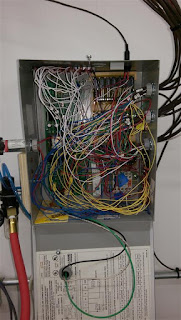I had the main tools all in and connected by the spring of 2014, and I had been using the shop for quite some time by now (tools were moved the previous winter), but I had not started on the ductwork for the final dust collection system until this time, even though I had the actual dust collector in place (ahem, "collecting dust...") since the previous summer. I had previously run 2 smaller dust collectors in the old house and had been rolling one of those around for use as needed here. I was tripping over everything in the shop as I had 2 extra dust collectors there and a general lack of organization, driven by lack of time. So getting ductwork ordered and hung plus my new systems started up was a big milestone in improving workflow. So here is the ductwork going up. I used the rolling scaffold to help out with this. It was quite a dance getting that around all the equipment already in place. I hadn't moved the lumber out of the old house at this point, so that helped a bit. This is Jan 2015. Happening in parallel with fixing up and clearing out the old house to be able to list it for sale:
And here is all the ductwork wrapped up and connected to everything:
The miter saw station was a tough one to do. I came up with a box and a floor register vent down below to get as much of the dust as possible. Miter saws are always tough to collect dust from, but this works OK. I could screen the front a bit more with some heavy plastic sheet to improve airflow, perhaps, but it's OK as is.
The real kick to the DC system is the automation. I created a system several years back, with an eye towards moving into the expanded shop where all the blast gates at each tool are pneumatically controlled. You press a button at the tool, the blast gate opens, and the DC starts up. It's really not complex, but of course each one of these tools needs its own control wires and tubing, so it looks like a rats nest of connections. This is a big time and hassle saver for me...at least once it was all done. A big thank you to my friend Chris K from RPI who helped me get the electronics all set up for this...many years ago...
The pneumatic control box on top, with the electronics box below (not completed yet)
The electronics control box completed. It looks worse than it is:
And one of the control switches that are at each tool. You can open/start the system, close it, or close all, in case another gate is open for another tool at the same time, or no matter where you are in the shop, you can shut it off without running around to find the tool that is on. But each one does have an indicator light so you know which one(s) is/are on.














No comments:
Post a Comment